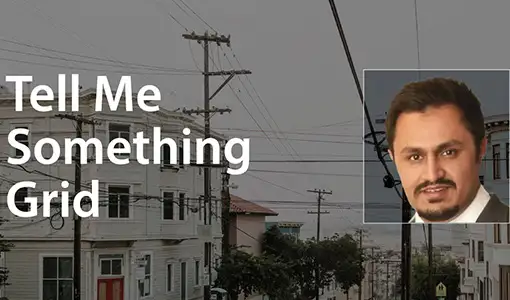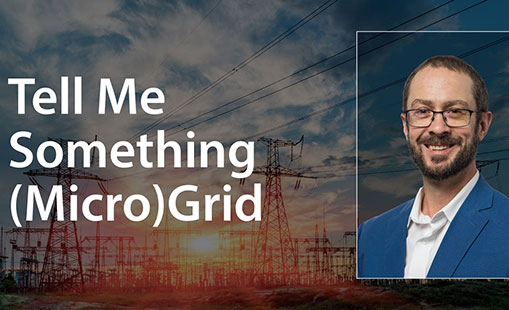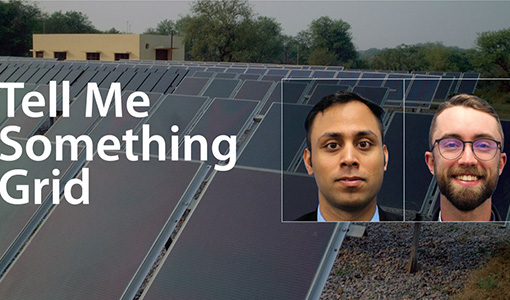Tell Me Something Grid Series
This series introduces some of NLR's outstanding researchers in grid modernization and shares how their work is shaping the grid of the future.

Browse below to meet some of NLR's expert grid researchers and get a behind-the-scenes look at their work to make the nation's electrical grid more flexible, reliable, resilient, and secure.

Data-Driven Strategies Fortify the Distribution Grid Against Extreme Events
Outages from severe weather can cut off heating and cooling, disrupt critical life-sustaining medical equipment, and halt essential services such as water treatment and communications. In this article, grid researcher Reiko Matsuda-Dunn shares how her team uses high-resolution data to understand and address the power grid's vulnerabilities during extreme weather events.

A Walk Through the Evolution of Distribution Grid Tools at NREL and Beyond
Over Aadil Latif's nearly 15 years in power systems research, he has seen grid modeling tools evolve dramatically to reflect the growing interactions between transmission and distribution. In his article, he walks through the evolution of distribution modeling tools at NLR and beyond. You'll learn about the sophistication of NLR tools today and exciting developments coming down the pike.

Microgrids Could Enhance Grid Resilience
The need for a resilient grid in the United States is growing due to electricity demand growth and the potential threats the grid faces, both natural and man-made. NLR grid researcher Rory McIlmoil draws on his experiences living in western North Carolina, where Hurricane Helene severely damaged local grids in September 2024, to explore how microgrids could be used to help grids recover more quickly from disasters.

How Industry Partnerships Can Help Tackle Real-World Grid Challenges
NLR Chief Scientist Yonghong Chen shares insights from over two decades of experience at Midcontinent Independent System Operator. In her role at NLR, Chen emphasizes the importance of industry collaboration for addressing real-world grid challenges. Her work focuses on efficient market design, grid operations, and planning for a renewable future. By partnering with electric companies and grid operators, Chen aims to drive innovative solutions that ensure grid reliability and resilience as the nation’s energy landscape shifts toward renewables.

The Path To Supply Energy to Every Home
The energy transformation offers opportunities to modernize the power system—with a surge in distributed solutions on the horizon. But modeling the future distribution grid is complex. NLR grid researcher Sherin Ann Abraham describes her research to understand how our current distribution power systems will need to change to keep up with and support the advanced energy transition. For instance, she is focusing on a more interdisciplinary modeling approach that ensures people have access to electricity.

A Look at the Future of Transmission: Getting Electrons to Where They Need To Be
Studies of electricity futures in the United States have shown that transmission capacity may have to more than double to support a cost-effective transition to a modernized grid. In this article, grid researcher Jarrad Wright describes his research on how a transformed power system with significant levels of transmission infrastructure might operate. This work is part of the National Transmission Planning Study led by the U.S. Department of Energy’s Grid Deployment Office and done in partnership with NLR and the Pacific Northwest National Laboratory.

Cutting-Edge Grid Planning Tools Drive India's Distributed Energy Future
India is hoping to achieve 40% renewable electricity capacity by 2030 and a key element to its grid planning is the incorporation of distributed energy resources. Grid Planning and Analysis Center analysts Kapil Duwadi and Erik Pohl dive into NLR’s role assisting India’s energy efforts, including distributed energy resource risk analysis, load distribution assessment, and developing tools for data management.

Top 10 Things To Know About Power Grid Reliability
There is a lot of planning and operations to ensure 24/7 access to reliable electricity that powers our homes, businesses, and communities. NLR Senior Research Fellow Paul Denholm shares what you need to know about the reliability of the U.S. power grid and why renewable energy can help keep the lights on. He highlights a package of resources to support energy system stakeholders with understanding the complicated world of reliable grid planning and operations.

Scaling and Aggregation Supercharge Electric Vehicle Charging
Distributed energy resources such as electric vehicles could support a more cost-effective and reliable bulk power system. But coordinating lots of distributed energy resources to benefit the grid and maximize cost savings can be complicated. Grid researcher Luke Lavin describes a study done in partnership with his transportation colleagues at the laboratory on the potential opportunities and pitfalls of different electric vehicle managed charging approaches.

New Modeling Approach Ensures All Perspectives Are Considered in Electricity Systems Evolution
The evolution of the electricity system has historically been modeled from the perspective of a single utility or central planner, with limited consideration of individual consumers and suppliers or societal objectives, incentives, and actions. But that approach is becoming less effective as electricity systems rapidly evolve. Grid researcher Elaine Hale describes a new modeling approach to ensure all perspectives are considered.

Unlocking Grid Potential Around the World With the Global Power System Transformation Consortium
It is critical to support system operators worldwide with managing the challenges related to integrating high levels of renewable energy. NLR senior grid researcher Amy Rose discusses her role leading a team that works directly with system operators in developing countries to implement the technical solutions needed to operate reliable, low-carbon grids.

Cambium Offers Forward-Looking, Publicly Available Data To Build Into Grid Planning Workflows
Making decisions about the future grid or grid-connected systems requires detailed data of estimated future U.S. emissions, costs, and electricity generation. NLR energy systems researcher Pieter Gagnon developed and updates Cambium, one of NLR’s many publicly available grid planning tools that offers electricity sector metrics at the hourly resolution to support detailed analysis of possible future grid conditions and impacts of potential decisions.

Strategic Planning Could Maximize the Benefits of Integrating Electric Vehicles Into Electricity Distribution Systems
Electricity distribution system planners are seeking more information about increased electricity demand from electric vehicles so they can strategically plan system upgrades, implement charging control methods, and develop new market solutions, if needed. NLR grid analyst Nadia Panossian discusses new research on how to best integrate lots of electric vehicles into distribution systems.

Protecting Power System Frequency With Increasing Distributed Energy Resources
Distributed energy resources with advanced controls can provide services to the grid such as frequency response. However, unlike conventional generators, distributed energy resources have to regularly exchange signals with faraway control centers. NLR grid analysts Wenbo Wang and Xin Fang discuss potential impacts of these open communications networks.
Join Us
Interested in shaping the future electric power system at NLR? Browse open positions and see what it's like to work here.
Stay Connected
Subscribe today to receive regular updates on what's happening in grid modernization and energy systems integration research at NLR and around the world.
Share
Last Updated Jan. 8, 2026
